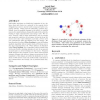1017 search results - page 154 / 204 » A routing algorithm for flip-chip design |
ALGOSENSORS
2009
Springer
14 years 2 months ago
2009
Springer
Sensor networks, with their ad hoc deployments, node mobility, and wireless communication, pose serious challenges for developing provably correct and efficient applications. A po...
BROADNETS
2004
IEEE
13 years 11 months ago
2004
IEEE
Survivability becomes increasingly critical in managing high-speed networks as data traffic continues to grow in both size and importance. In addition, the impact of failures is e...
MONET
2008
13 years 7 months ago
2008
Wireless networks that operate on batteries are imposed with energy constraints and long distance communications between nodes are not desirable. Implementing Relay Nodes (RNs) can...
ICCAD
2004
IEEE
14 years 4 months ago
2004
IEEE
This paper presents the Routing Cost Valleys (RCV) algorithm – the first published algorithm that simultaneously optimizes all short- and long-path timing constraints in a Field...
SAC
2009
ACM
14 years 2 months ago
2009
ACM
Self-healing gradients are distributed estimates of the distance from each device in a network to the nearest device designated as a source, and are used in many pervasive computi...

